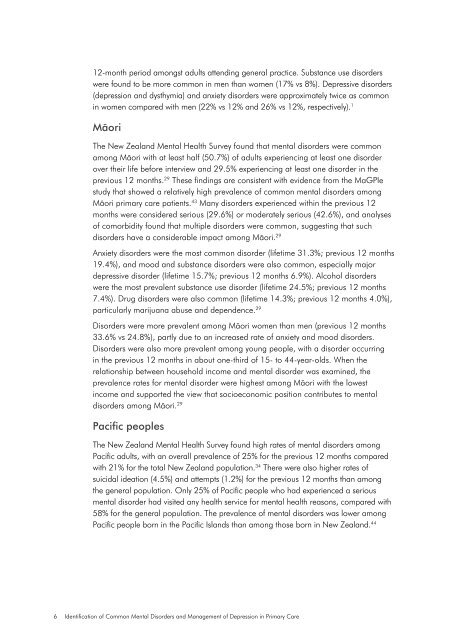Common Mental Disorders Depression - New Zealand Doctor
Common Mental Disorders Depression - New Zealand Doctor
Common Mental Disorders Depression - New Zealand Doctor
Create successful ePaper yourself
Turn your PDF publications into a flip-book with our unique Google optimized e-Paper software.
12-month period amongst adults attending general practice. Substance use disorders<br />
were found to be more common in men than women (17% vs 8%). Depressive disorders<br />
(depression and dysthymia) and anxiety disorders were approximately twice as common<br />
in women compared with men (22% vs 12% and 26% vs 12%, respectively). 1<br />
Mäori<br />
The <strong>New</strong> <strong>Zealand</strong> <strong>Mental</strong> Health Survey found that mental disorders were common<br />
among Mäori with at least half (50.7%) of adults experiencing at least one disorder<br />
over their life before interview and 29.5% experiencing at least one disorder in the<br />
previous 12 months. 29 These findings are consistent with evidence from the MaGPIe<br />
study that showed a relatively high prevalence of common mental disorders among<br />
Mäori primary care patients. 43 Many disorders experienced within the previous 12<br />
months were considered serious (29.6%) or moderately serious (42.6%), and analyses<br />
of comorbidity found that multiple disorders were common, suggesting that such<br />
disorders have a considerable impact among Mäori. 29<br />
Anxiety disorders were the most common disorder (lifetime 31.3%; previous 12 months<br />
19.4%), and mood and substance disorders were also common, especially major<br />
depressive disorder (lifetime 15.7%; previous 12 months 6.9%). Alcohol disorders<br />
were the most prevalent substance use disorder (lifetime 24.5%; previous 12 months<br />
7.4%). Drug disorders were also common (lifetime 14.3%; previous 12 months 4.0%),<br />
particularly marijuana abuse and dependence. 29<br />
<strong>Disorders</strong> were more prevalent among Mäori women than men (previous 12 months<br />
33.6% vs 24.8%), partly due to an increased rate of anxiety and mood disorders.<br />
<strong>Disorders</strong> were also more prevalent among young people, with a disorder occurring<br />
in the previous 12 months in about one-third of 15- to 44-year-olds. When the<br />
relationship between household income and mental disorder was examined, the<br />
prevalence rates for mental disorder were highest among Mäori with the lowest<br />
income and supported the view that socioeconomic position contributes to mental<br />
disorders among Mäori. 29<br />
Pacific peoples<br />
The <strong>New</strong> <strong>Zealand</strong> <strong>Mental</strong> Health Survey found high rates of mental disorders among<br />
Pacific adults, with an overall prevalence of 25% for the previous 12 months compared<br />
with 21% for the total <strong>New</strong> <strong>Zealand</strong> population. 34 There were also higher rates of<br />
suicidal ideation (4.5%) and attempts (1.2%) for the previous 12 months than among<br />
the general population. Only 25% of Pacific people who had experienced a serious<br />
mental disorder had visited any health service for mental health reasons, compared with<br />
58% for the general population. The prevalence of mental disorders was lower among<br />
Pacific people born in the Pacific Islands than among those born in <strong>New</strong> <strong>Zealand</strong>. 44<br />
6<br />
Identification of <strong>Common</strong> <strong>Mental</strong> <strong>Disorders</strong> and Management of <strong>Depression</strong> in Primary Care

















